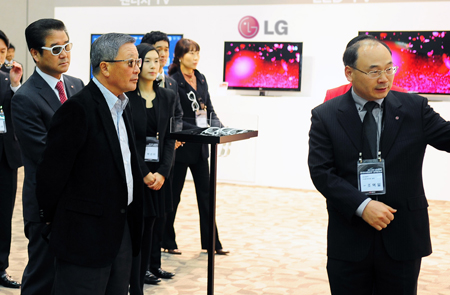A game of chicken

LG Group Chairman Koo Bon-moo, left in front row, is briefed by LG Electronics executive Cho Taek-il on the firm’s 3D OLED TVs during a recent visit to LG’s technology compound in Paju, Gyeonggi Province. Samsung and LG are involved in a fight for leadership in the OLED TV market in an attempt to find next revenue sources amid stalling demand for LCD-embedded products.
Samsung tussles with LG in OLED market
Oversupply is slowing growth in the global display industry triggering another “game of chicken” in this already cutthroat market.
The world’s top flat-screen makers ― Samsung and LG Display ― have been competing fiercely to take the lead in advanced displays called OLED (organic light-emitting diode).
“Because global liquid crystal displays (LCD) are gradually being phased out, Samsung wants to get the upper hand in the OLED market by ensuring better technology than that of LG’s. Of course LG is not going to sit back and let that happen,’’ said Hwang Joon-ho, an analyst at Daewoo Securities.
As LCD prices began experiencing significant decline major LCD makers including LG Display, the world’s second-biggest LCD supplier, and Taiwan’s Chi Mei Innolux (CMI), reported wider-than-expected losses. Oversupply and a lower-than-expected demand for televisions push down prices further.
LCD is the vital component for use in almost all digital devices from televisions, smartphones, and tablets to monitors. The sector is highly-volatile and cyclical subject to economic fluctuations. When economies are struggling, consumers usually withhold spending on upgrades or buying new devices.
The 2012 outlook for the LCD industry also remains bleak, shadowed by industry slowdown, profit squeeze, layoffs, mergers and acquisitions (M&A) and restructuring.
LG Display said Monday that it has reorganized its business structure to boost management efficacy. Some layoffs are expected as the flat-screen maker streamlines, according to LG in a statement.
LG scrapped its plan to build a TV manufacturing line at its plant in Poland, and departed from L&T Display Technology _ the joint venture with LG Display and China’s TPV.
BNP Paribas expects the LCD TV industry to fall by 3 to 4 percent per year in the years to come.
“The LCD business was once-regarded as a major cash cow. But the sector isn’t so lucrative anymore because of so many suppliers. Korean LCD makers can’t charge more. The LCD business isn’t a `golden goose’ anymore,’’ said a high-ranking official from Samsung Display, Tuesday.
He expects a number of LCD suppliers to crash and burn. “Major players are playing a game of chicken in the LCD industry,’’ said an analyst from iSuppli, a market research firm, who asked not to be identified.
Playing chicken in the business prevents each player from yielding for as long as possible even when they suffer loss. Likewise, when most players push this strategy invariably LCD prices will drop lower and lower, causing a more serious downturn for everyone in the industry.
The market is being divided up by the top three companies ― Samsung Display, LG Display and Taiwan’s Hon Hai, a mother company for CMI. Hon Hai is the biggest stake holder in Japan’s struggling Sharp.
Samsung Electronics spun off its LCD unit to launch Samsung Display, in an agreemnt to take over S-LCD and Samsung Mobile Display (SMD) in April. The merged entity will be incorporated from July.
Samsung is building a cutting-edge LCD plant in the southern Chinese city of Suzhou. Meanwhile rival LG Display will start construction of its biggest-ever overseas LCD plan in Guangzhou from May 22.
“Samsung, LG and Taiwan’s CMI will eventually survive as their LCD-making technologies are the most advanced,’’ said So Hyun-chul, an analyst at Shinhan Financial and Investment.
LCD technology is quite similar to semiconductor technology. Advanced technology means better pricing and cost efficiency.
OLED marathon
As part of the manufacturers’ desperate efforts to stay afloat in this highly-competitive industry, Samsung and LG are increasing their investments in OLEDs.
“OLEDs are the stronger candidate as a replacement to LCD panels enough so that the decline of LCDs actually reflects the growth of the OLED market. Korean firms believe OLED will be the next cash-generator and tensions are very high,’’ said Euh Kyu-jin, an analyst at IBK Securities.
Both Samsung and LG race to gain “first-mover’’ advantage in the global OLED market.
Samsung is leading the market for small- and medium-sized OLED panels for use in smartphones and tablets. But LG is more profitable in large-sized OLED panels for use in televisions.
Taiwan’s AUO is collaborating with Japan’s Sony to produce OLED screens for televisions. “The flat-screen industry is seeing a paradigm shift,’’ said the iSuppli analyst.
“It’s a matter of pride,’’ said an official from Samsung Display. “This is the market that LG should pursue. We can’t lose this opportunity,’’ said an official from LG Display.
LG Display is planning to bring the recent “OLED tech leak’’ case with Samsung to domestic courts. LG believes Samsung’s claim that LG tried to steal Samsung-owned OLED techs is “totally groundless.’’
Senior Korean prosecutors raided LG Display’s Seoul office recently to find out whether LG illegally acquired OLED techs from its rival Samsung, LG officials confirmed.
Korean police were already investigating a case of key technology leaking from Samsung to LG. This technology is Samsung’s
“Small Mask Scanning,’’ used to produce OLED on large substrates. But this is strange as they are using completely different front plane architecture in their own large panel production and this technology does not require fine patterning.
11 people were arrested in the case ― former and current researchers at Samsung and employees of LG.
“Samsung is using the so-called `RGB’ technology, while LG is pushing the so-called `White’ technology. The scandal reflects Samsung’s uneasiness about LG in an OLED tussle amid the stalling momentum in the LCD business,’’ said Chung Hee-tae, a professor at the Korea Advanced Institute of Science and Technology (KAIST). <Korea Times/Kim Yoo-chul>
























































